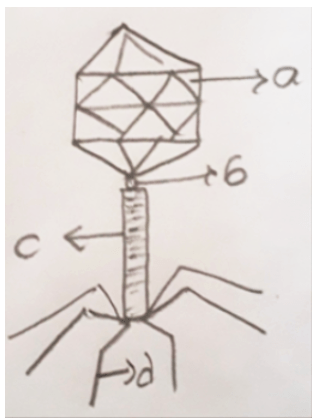This set of Class 11 Biology Chapter 2 Multiple Choice Questions & Answers (MCQs) focuses on “Biological Classification – Viruses, Viroids and Lichens – 2”.
1. Read the following paragraph and answer the following question.
Hershey-Chase experiment broke the barriers of science and expanded the understanding of life. In this experiment, two sets of bacteriophages are used in which one contains radioactive sulphur in its protein coat (Set-I) and other contains radioactive phosphorus in its DNA (Set-II). These two sets were allowed reproduce in E.Coli culture and then centrifuged.
Which among the following are correct Set-I and Set-II after centrifugation?
a) Set-I and Set-II contains radioactive sulphur and phosphorous in their supernatant respectively
b) Set-I and Set-II contains radioactive sulphur in their supernatant
c) Set-I contains radioactive sulphur in its pellet and set-II contains radioactive phosphorous in its supernatant
d) Set-I and Set-II contains radioactive sulphur and phosphorous in their pellet respectively
View Answer
Explanation: Set-I contains radioactive sulphur in its pellet and set-II contains radioactive phosphorous in its supernatant. This is because T2 bacteriophages replicates by injecting DNA into E.Coli whereas the protein coat remains outside E.Coli. This mixture when centrifuged forms sediment and pellet containing DNA and protein coat respectively.
2. Viruses are smaller than viroids.
a) True
b) False
View Answer
Explanation: Viroids are smaller than viruses. Viroids don’t contain protein coat whereas viruses do contain. Both viroids and viruses are pathogenic i.e. both of them cause diseases.
3. Which among the following is not a difference between viruses and viroids?
a) Viruses contain DNA whereas viroids don’t contain DNA
b) Viruses contain protein coat whereas viroids don’t contain protein coat
c) Viruses contain RNA whereas viroids don’t contain RNA
d) Viruses are found in bacteria, animals and plants but viroids only in plants
View Answer
Explanation: Viruses contain both RNA and DNA whereas viroids contains. Viruses contain protein coat whereas viroids don’t contain protein coat. Viruses are found in bacteria, animals and plants but viroids only in plants.
4. Who discovered viroids?
a) T.O. Diener
b) Alexander Flemming
c) W.M. Stanley
d) Robert Hooke
View Answer
Explanation: T.O. Diener discovered viroids in 1971. He found that these infectious agents are smaller than viruses and are the main cause for potato spindle tuber disease.
5. Which among the following is odd?
a) Mumps
b) Small pox
c) Influenza
d) Potato spindle tuber disease
View Answer
Explanation: Mumps, small pox, herpes and influenza are caused due to viruses. Whereas, T.O.Diener in 1971 discovered that potato spindle tuber disease is caused by set of pathogens that are similar to viruses and named them as viroids.
6. Which among the following is incorrect about the following figure?

a) The protein coat is made of hexagonal units called capsomeres
b) The protein sheath is called capsid
c) The substance in “a” is made of saccharides
d) The four main parts shown in the above figure are head, collar, sheath and tail fibres
View Answer
Explanation: The part “a” refers to head and contains genetic material made of nucleotides i.e. either DNA or RNA. The protein sheath present is called capsid and is made of hexagonal units called capsomeres. The four main parts shown in the above figure are head, collar, sheath and tail fibres.
7. AIDS stands for _______
a) Acquired Immuno Deficiency Syndrome
b) Acquired Immuno Disease Syndrome
c) All India Disease Syndromes
d) Aided Institute for Development and Sciences
View Answer
Explanation: AIDS stands for Acquired Immuno Deficiency Syndrome and is caused by a virus called Human Immunodeficiency Virus (HIV). Symptoms of this disease include night sweats, loss of apetite, diarrhoea, loss of eye sight and malaise etc.
8. The fungal portion in Lichens is known as _________
a) Mycobiant
b) Phycobiant
c) Capsobiant
d) Deuterobiant
View Answer
Explanation: Lichens exist in symbiotic associations with algae and fungi. The algal and fungal components in Lichens are known as Phycobiant and Mycobiant respectively.
9. RNA of the viroids is of low molecular weight when compared to viruses.
a) True
b) False
View Answer
Explanation: RNA of the viroids is of low molecular weight when compared to viruses. Viroids are comparatively smaller than viruses. They also lack protein sheath that is found in viruses.
10. Lichens are indicators of pollution because ________
a) They grow in oxygen depleted regions
b) They don’t grow in polluted regions
c) They grow in polluted regions
d) Their growth indicates that the region has very high carbon levels
View Answer
Explanation: The co-existence of algae with fungus is called lichens. Lichens are the best examples of symbiotic association. They are also good indicators of pollution as they don’t grow in polluted regions.
Sanfoundry Global Education & Learning Series – Biology – Class 11.
To practice all chapters and topics of class 11 Biology, here is complete set of 1000+ Multiple Choice Questions and Answers.
If you find a mistake in question / option / answer, kindly take a screenshot and email to [email protected]
- Practice Class 11 - Mathematics MCQs
- Practice Class 11 - Physics MCQs
- Practice Class 11 - Chemistry MCQs
- Check Class 11 - Books
- Practice Class 12 - Biology MCQs
